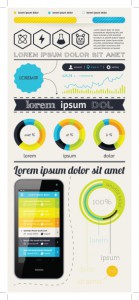Responsive web design (RWD) is an approach to web design that mobile developers use to optimize the user's experience on the web site across a wide range of viewing devices, from desktop monitors to mobile phones.
This approach facilitates navigation and reading of the website by minimizing the panning, resizing and scrolling that users must perform. Developers with web design careers use RWD to adapt a web page's layout to the user's viewing device with techniques such as proportion-based grids. The Mobile Web Design Blog describes how these developers convert a grid with a fixed width to one with a proportionate width.
Overview
The increasing popularity of RWD means that web designers are likely to select this approach for web sites for mobile devices. The creation of a flexible grid is one of the first tasks that designers will perform when creating a web page. The viewing area of a traditional web page is based on pixels, meaning that the width of each element in the viewing area is a specific number of pixels. Users who view this type of web page with a small viewing device such as a mobile phone can't see the entire page at once and must therefore spend more time scrolling and zooming.
Grid Conversion
The primary task in converting a web page from a fixed width to a flexible grid is to replace the pixels in your div elements with percentages. This task requires you to calculate the width of your current element in terms of its parent element's width. Calculate this percentage by dividing the number of pixels in your current element's width by the number of pixels in the parent element's width and multiplying that quotient by 100. Assume for this example that the current element has a width of 23 pixels and the parent element's width is 50 pixels. The width of the current element is therefore 23/50 x 100 = 46 percent of the parent element's width. You would then replace the width of 23 pixels for the current element with a width of 46 percent.
Repeat this procedure for all of the elements on the web page. The width of all elements on this page will now be expressed in terms of its parent element's width. This page's grid will now respond to the size of the viewing device, greatly improving the experience of mobile users.
Summary
The creation of a responsive grid is one of the first steps in RWD, but it isn't the only one. RWD also requires developers to size image in relative units to keep them within their containing element. This design approach means that media queries can use CSS style rules based on the viewing device's characteristics, especially its width. RWD also involves the server performing tasks that are traditionally handled by the user's device, allowing pages to load more quickly. This feature is especially beneficial for mobile devices that have relatively slow download speeds.
Contact us today to learn more.



